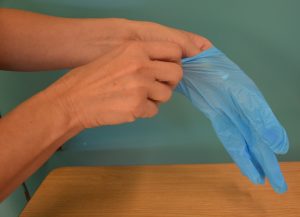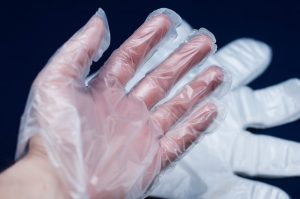The hands should be kept above the waist at least 6 inches when wearing sterile gloves. If they’re below the waist, there’s a greater chance of them becoming dirty or contaminated.
Wearing the gloves up to the elbows protects the arms and hands from potential contaminants and also keeps them warm in cold environments. Additionally, keeping your hands above your waist will help you avoid contact with any contaminants that may be on your clothing or body.
When Gloving Dominant Hand Where Should the Nondominant Hand Grasp the Sterile Glove?

The non-dominant hand should grasp the glove on the inside surface of the glove to help prevent contaminating the dominant hand. If you need to remove a glove, do so by grasping it on the outside surface with your dominant hand so that you don’t contaminate the inside of the gloves.
it’s all about what feels most comfortable for you. Some people prefer to grip the glove with their non-dominant hand, keeping their fingers close to the inside surface of the glove. This can help provide a little more stability and control when throwing.
Others prefer to hold the glove by the strap with their non-dominant hand, letting their dominant hand do all of the gripping and throwing. This can give you a little more freedom of movement in your dominant hand and can be helpful if you’re doing a lot of pitching.
Why are Sterile Conditions Maintained
Sterile conditions are maintained in order to prevent the spread of infection. By keeping the environment clean and minimizing contact with potential sources of infection, we can reduce the risk of developing an illness.
The use of sterile techniques is especially important in hospitals and other healthcare settings, where patients are vulnerable to infection and may have weakened immune systems.
By strictly following protocols for sterilization and disinfection, we can help protect our patients from harm.
How do I Know to Break a Sterile Technique
breaking sterile technique means that you have introduced contamination into a sterile field. There are a few ways this can happen
- Touching something that is not sterile with your hands
- Dropping something into the surgical area that is not sterile
- Allowing something to escape from a sterile field (such as bacteria or air)
- Surgical smoke or particles from equipment
- Not wearing gloves when you should be wearing gloves
Another way is to not properly disinfect your hands or equipment before beginning the sterilization process. Finally, you can also contaminate the sterilized equipment by not properly handling it after it’s been cleaned.
What Happens When Sterile Technique is Broken
When the sterile technique is broken, it increases the risk of infection.
The sterile technique is a set of guidelines for preventing the spread of infection. It’s used in medical and laboratory settings to protect patients and staff from exposure to harmful microorganisms.
If the sterile technique is broken, it increases the risk of infection. Infections can cause serious health problems, including death. It’s important to follow sterile technique guidelines closely to reduce the risk of infection.
How Far Should I Stand from Sterile Field
When you’re in a sterile field, the assumption is that you’re not carrying any dirt or anything on your clothing that could contaminate the equipment or other surfaces in the area.
If someone who’s not sterile comes too close, they could potentially introduce bacteria, which would then jeopardize the sterility of the entire area.
That’s why it’s important for unsterile people to stand at least 12 inches away from anything that’s considered to be sterile. It minimizes the chances of any contaminants being introduced into the field.
How Does Putting on Sterile Gloves Differ From Putting on non-Sterile Gloves?

The main difference between sterile and non-sterile gloves is that sterile gloves have been through a sterilization process, while non-sterile gloves have not.
Sterilization is the process of killing all microorganisms on an object, such as medical supplies or instruments. There are many ways to sterilize objects, but one of the most common methods is to use steam Autoclaving. Autoclaving uses high pressure and heat to kill microorganisms.
Non-sterile gloves may be treated with chemicals that kill some but not all microorganisms. However, because these chemicals are not 100% effective, there is always a risk of contamination when using non-sterile gloves.
Where are Sterile Items Kept
Sterile items are kept in a clean, dry place away from contaminants. Some common places to store sterile items include a laminar flow hood or a biocontainment cabinet.
The room is usually temperature-controlled and kept as free of dust and other contaminants as possible.
A cleanroom is a facility where the concentration of particles in the air is controlled to minimize the number of microorganisms. The air quality and pressure are also controlled to prevent contamination.
When is it necessary to discard gloves?
Gloves should be discarded after the task is completed or when they are visibly soiled, wet, or contain a puncture.
When gloves are removed, contaminants may be transferred to the hands. If gloves are not replaced, these contaminants can be spread to other areas of the body or to work surfaces. When gloves become contaminated, it’s important to take steps to prevent the spread of contamination.
Contaminated gloves should be placed in a bag that can be sealed and then disposed of properly. It’s also important to decontaminate hands and any other areas that may have been exposed to the hazardous material.

I am not a good blogger but I started blogging when I was in my college. one day scrolling my social media pages and top of the page one notification was coming like this “ earn money from blogging”.then I clicked that notification. After that, I was confused that which niche is better for me. Finally, I selected the niche and I was comfortable with that glove’s reviewer.

